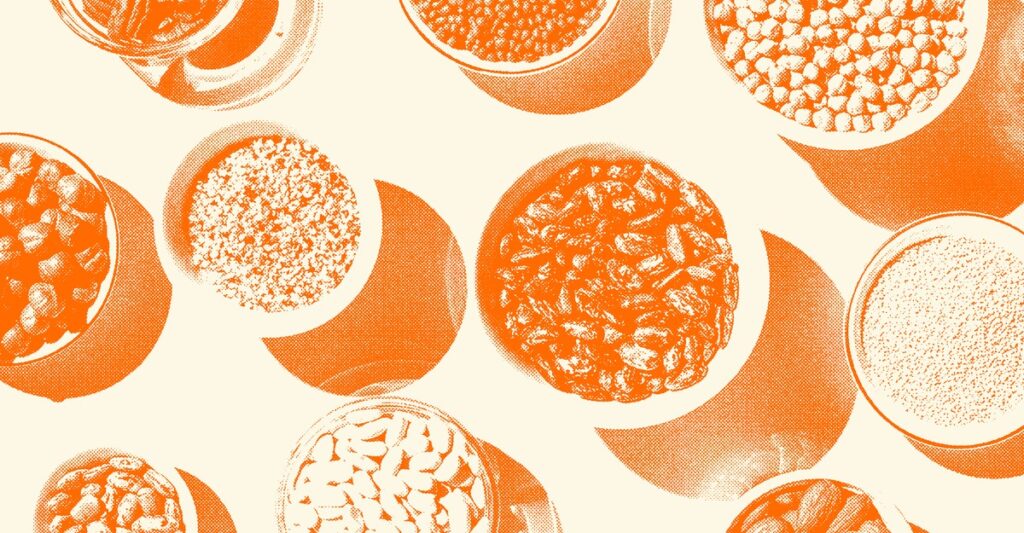The bean has the potential to remake American diets, but it has an image problem.
This is an edition of Time-Travel Thursdays, a journey through The Atlantic’s archives to contextualize the present, surface delightful treasures, and examine the American idea.
I love a good bean: tossed with vinaigrette in a salad, spooned over pasta, served on a plate with rice and corn. The bean is a powerful little food, all the more for its shapeshifting capacities. Many people can appreciate that these legumes are cheap and healthy, but they still fall short of widespread adoration or even respect.
Yet, over the decades, Atlantic writers have turned to the bean’s revolutionary potential again and again. The humble bean, small, unglamorous, packed with protein, has been a source of inspiration for those seeking to remake the food system, fight climate change, and add some better flavors into American homes. In a 1975 article loftily titled “A Bean to Feed the World?” the historian Richard Rhodes made the case for centering the soybean in the American diet. “We continue to sing of amber waves of grain, not dusty pods of beans,” he bemoans in the opening line.
Noting that the soybean was, at the time, the No. 1 cash crop in the country, Rhodes argues that Americans should be eating it as a source of protein on its own, rather than feeding it to the farm animals that then became dinner. “Conversion of soybeans to food for humans is worth looking at,” he writes. (The soybean, a cousin of the lentil and black bean, has about 30 grams of protein per cup.) Alas, soybeans remain primarily the provenance of livestock today, with the exception of the small percentage used to make popular foods such as tofu.
In 2017, James Hamblin made the urgent climate case for replacing beef with legumes in Americans’ diets, given that cows are among the top agricultural sources of greenhouse gases worldwide and take up great swaths of arable land. Hamblin explained that by swapping beans for beef, the U.S. could “achieve somewhere between 46 and 74 percent of the reductions needed” to meet the 2020 greenhouse-gas-emission goals set out by President Barack Obama in 2009. (Americans have not wholesale rejected beef in favor of beans, but, in large part because the pandemic slowed travel and economic activity, we did end up meeting those climate goals.)
Part of the problem with beans is that they are not that attractive a food. In a 1992 article, the food writer Corby Kummer acknowledges the “insipid” nature of beans before walking readers through some ways to prepare tasty—and easily digestible—bean-based dishes. But for the horticultural writer Richardson Wright, the bean’s humility is what makes it heroic. During World War II, he wrote that “the coincidence of Saturday night and baked beans was of divine provenance, and with the ardor of the freshly converted, I insisted that we practice.” In a time of loss, a pot of beans—which he calls “farinaceous catechumens,” likening them to starchy bodies readied for baptism—can mean everything. The quasi-religious tone of his Proustian meditation on beans is moving; still, his dietary choice was borne out of desperation and limited rations.
The image of beans as a backup when you don’t have, or can’t afford, anything better has proven hard to shake. Even as vegetarian diets are on the rise and Americans recognize the environmental impact of beef, eating meat remains an intractable part of American life. For all the trendiness of brothy beans and Rancho Gordo subscriptions in recent years, many Americans still haven’t made legumes central to their diets. One estimate found that, as of 2019, the average American ate approximately 55 pounds of chicken a year compared with roughly 2.5 pounds of cooked black beans (American bean consumption is low compared to many other countries). Still, there are reasons to hope: Americans have embraced hummus, which is made of chickpeas. Chic New York restaurants are serving bean-based dishes. And a climate campaign with ties to the United Nations is pushing to double global bean consumption by 2028. Though the bean may not be the flashiest ingredient, it is persistent—and it may even shape a better world in its image.


